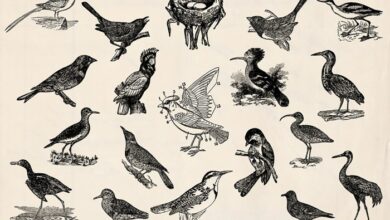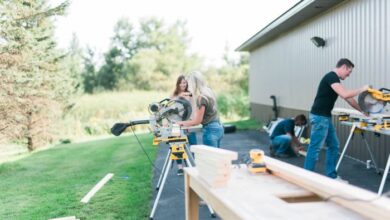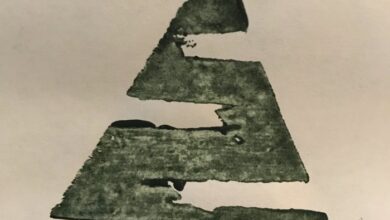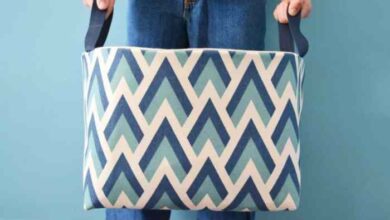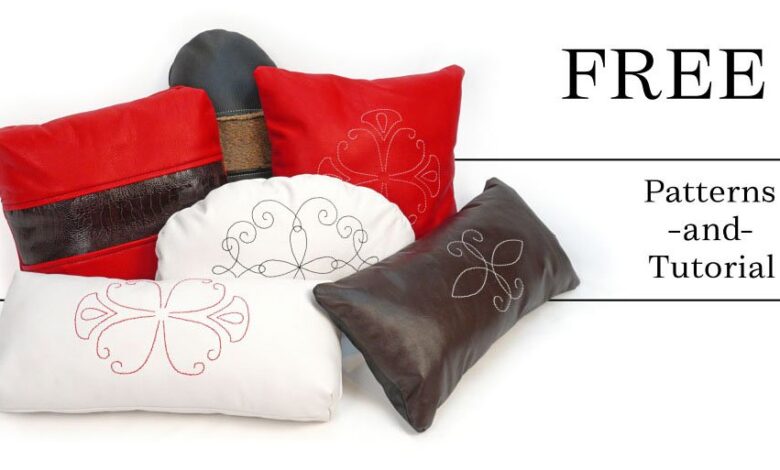
Textured leather pillow DIY is a project that combines creativity with practicality, allowing you to elevate your home decor with a touch of elegance and comfort. Leather, with its inherent durability and timeless appeal, offers a unique texture that adds a touch of sophistication to any space.
From the subtle grain of a distressed leather to the bold patterns of embossed designs, textured leather pillows offer a range of visual and tactile experiences that can transform your living room, bedroom, or even outdoor patio.
This project is not only about creating beautiful and functional pillows, but also about embracing the rewarding process of crafting something unique with your own hands. The journey from selecting the right leather to stitching the final seams is a journey of discovery, allowing you to express your personal style and create a piece that reflects your individual taste.
Introduction to Textured Leather Pillows
Textured leather pillows bring a touch of luxury and sophistication to any space. Their unique visual and tactile qualities make them a popular choice for those seeking a unique and stylish home decor element.
Types of Leather Textures for Pillows
The texture of leather plays a crucial role in the overall aesthetic and feel of a pillow. Here are some popular leather textures commonly used for pillows:
- Embossed Leather:This type of leather features intricate patterns pressed into the surface, creating a visually appealing and tactile experience. Examples include geometric patterns, floral designs, and animal prints.
- Distressed Leather:Distressed leather has a vintage and rustic appeal. It is characterized by its natural markings, scratches, and imperfections, adding a touch of character and authenticity.
- Suede Leather:Suede is known for its soft and velvety texture. It offers a luxurious feel and is often used for pillows that provide a cozy and inviting atmosphere.
- Nubuck Leather:Nubuck leather has a slightly rougher texture than suede but is still soft and supple. It offers a unique look and feel, adding a touch of rugged elegance.
Choosing the Right Leather
Choosing the right leather for your DIY textured leather pillows is crucial for achieving the desired look, feel, and durability. The type of leather you select will influence the overall aesthetic, comfort, and longevity of your pillows.
Leather Thickness
Leather thickness is a significant factor to consider, as it affects the pillow’s structure, firmness, and stitching ease. Thicker leather is generally more durable and provides a sturdier base for the pillow. However, it can be more challenging to stitch and might result in a less pliable and comfortable pillow.
- For pillows with a more defined and structured shape, a thicker leather with a thickness of 3-4 ounces is recommended. This thickness offers good support and durability.
- For pillows that prioritize comfort and a softer feel, a thinner leather with a thickness of 2-3 ounces is a better choice. It is more flexible and easier to stitch.
Leather Durability
The durability of leather is crucial for ensuring your pillows withstand regular use and maintain their quality over time. Leather durability is influenced by its tanning process, type of hide, and finishing.
- Full-grain leather is considered the most durable type, as it retains the natural grain and top layer of the hide. It is resistant to scratches and wear and tear, making it suitable for high-use pillows.
- Top-grain leather is also durable but has a slightly smoother finish as the top layer of the grain has been sanded. It is a good option for pillows that require a more refined look.
- Split leather is less durable than full-grain or top-grain leather, as it is made from the lower layer of the hide. It is often used for budget-friendly projects, but it is less resistant to wear and tear.
Leather Suitability for Stitching
Stitching leather can be challenging, especially for thicker hides. The type of leather you choose should be suitable for stitching, considering its thickness, flexibility, and grain pattern.
- Leather with a tighter grain pattern is easier to stitch, as it provides a more consistent surface for the needle to penetrate.
- Leather with a looser grain pattern can be more difficult to stitch, as the needle may slip or tear the leather.
Types of Leather for Pillows
Several types of leather are commonly used for pillows, each with its unique characteristics and suitability.
- Full-grain leatheris the most durable and luxurious option, offering a natural grain and a rich, aged look. It is ideal for pillows that require a high level of quality and longevity.
- Top-grain leatheris a more affordable option than full-grain leather, offering a smooth and refined finish. It is suitable for pillows that prioritize a sleek and modern look.
- Nubuck leatheris a type of top-grain leather that has been sanded and brushed to create a soft, velvety texture. It is ideal for pillows that prioritize comfort and a luxurious feel.
- Suede leatheris a type of split leather that has been brushed to create a soft, velvety texture. It is a more affordable option than nubuck leather but less durable.
Essential Materials and Tools
This DIY project requires specific materials and tools for a successful outcome. Gathering everything beforehand ensures a smooth and enjoyable crafting experience.
Leather Selection
Choosing the right leather is crucial for your pillow. The type of leather determines its durability, texture, and overall appearance.
- Full-grain leather: This is the highest quality leather, known for its durability and natural markings. It ages beautifully and develops a unique patina over time.
- Top-grain leather: This leather is slightly less expensive than full-grain, as the top layer of the hide has been sanded to create a smoother finish.
It’s still durable and offers a good balance of quality and affordability.
- Split leather: This leather is made from the lower layer of the hide, making it less durable than full-grain or top-grain. It’s often used for upholstery and craft projects where durability isn’t a primary concern.
Essential Tools
A few essential tools are needed for this project:
- Sewing machine: This is essential for stitching the leather pieces together.
- Leather needles: These needles are specifically designed for sewing through thick leather.
- Heavy-duty thread: This thread is strong enough to hold the leather pieces together.
- Scissors: Use sharp scissors to cut the leather accurately.
- Rotary cutter: This tool is optional but highly recommended for precise cutting, especially for large pieces of leather.
- Cutting mat: This protects your work surface and provides a stable base for cutting.
- Ruler: This helps you measure and mark the leather accurately.
- Marking pen: Use a marking pen to draw your pattern on the leather.
- Hammer: This is used to flatten the leather after cutting.
- Sewing awl: This tool helps to make holes in the leather for stitching.
- Leather conditioner: This helps to keep the leather soft and supple.
Stuffing Materials
The stuffing material provides the pillow’s comfort and shape.
- Polyester fiberfill: This is a common and affordable stuffing material. It’s lightweight and provides good support.
- Down feathers: These provide a luxurious and fluffy feel. They’re more expensive than polyester fiberfill but offer excellent comfort.
- Buckwheat hulls: These are a natural and eco-friendly stuffing material.
They provide good support and breathability.
Shopping List
Here’s a shopping list with potential suppliers for the materials you’ll need:
- Leather:
- Tandy Leather Factory: https://www.tandyleatherfactory.com/
- Leathercraft.com: https://www.leathercraft.com/
- Etsy: https://www.etsy.com/
- Stuffing:
- Joann Fabrics: https://www.joann.com/
- Amazon: https://www.amazon.com/
- Tools:
- Amazon: https://www.amazon.com/
- Walmart: https://www.walmart.com/
Designing the Pillow Shape and Size: Textured Leather Pillow Diy

The shape and size of your leather pillow will significantly influence its overall look and feel. You can choose from classic rectangular designs or explore more unique and creative shapes to add a personal touch to your project. The dimensions you select will also determine the amount of leather you need and the complexity of the sewing process.
Basic Pillow Shape and Size
This section discusses the dimensions and pattern creation for a basic pillow shape.The most straightforward design for a textured leather pillow is a rectangular shape. A standard size for a rectangular pillow is 16 inches by 16 inches (40 cm by 40 cm).
This size is comfortable for lounging and provides ample space to showcase the leather’s texture.Here are the steps for creating a pattern for a basic rectangular pillow:
1. Draw the shape
On a piece of paper, draw a rectangle with the desired dimensions. For example, you can use a ruler to draw a rectangle that is 16 inches wide and 16 inches tall.
Crafting a textured leather pillow is a fun and rewarding project. It’s a great way to add a touch of luxury to your home, and it’s surprisingly easy to do. I’m always inspired by new game releases, and recently I learned that project athia is now forspoken , which has me even more excited to create a new pillow with a unique design.
The intricate details and textures in the game have me wanting to incorporate similar elements into my next DIY project. I think the finished pillow will look great on my couch, and I can’t wait to get started!
2. Add seam allowance
I’m so excited about my latest DIY project: textured leather pillows! The rich, tactile feel of the leather is just so luxurious. And while I’m on the topic of luxurious design, I just had to share that Kilkenny Design’s Stanley collection is now available online and in stores kilkenny design stanley now available online in store.
Their pieces are perfect for adding a touch of sophistication to any space. Back to the pillows, I’m thinking of using some vintage leather scraps for a truly unique look.
Add a seam allowance of ½ inch (1.25 cm) to all sides of the rectangle. This will create a total width of 17 inches and a total height of 17 inches.
3. Cut out the pattern
Carefully cut out the rectangle, including the seam allowance.
Crafting a textured leather pillow is a great way to add a touch of rustic elegance to your home. The rich texture and natural color variations of leather make it a beautiful material to work with, and the process of creating a pillow from scratch is incredibly rewarding.
When it comes to photographing your finished project, remember to pay attention to the light and the way it interacts with the leather. You can learn some great photography tips from a color story here to capture the true beauty of your handmade creation.
Once you’ve captured the perfect shot, you’ll be able to show off your unique and stylish pillow to the world.
4. Transfer the pattern
Use the pattern to cut two identical pieces of leather.
Designing Different Shapes and Sizes
Here are suggestions for different shapes and sizes based on desired aesthetics.You can experiment with various shapes and sizes for your textured leather pillow. Here are a few ideas:
- Square Pillow:A square pillow offers a clean and modern aesthetic. You can create a square pillow with sides of 16 inches (40 cm) or adjust the size to suit your preferences.
- Round Pillow:A round pillow adds a touch of softness and comfort to any space. To create a round pillow, you can draw a circle on paper with the desired diameter and then cut out the shape. You can use a compass or trace a circular object to create the circle.
- Oval Pillow:An oval pillow offers a slightly more elongated shape than a round pillow. You can create an oval pillow by drawing an oval on paper and then cutting out the shape. You can use a template or freehand the oval shape.
- Heart Pillow:A heart pillow adds a touch of romance and whimsy to any space. You can create a heart pillow by drawing a heart shape on paper and then cutting out the shape. You can use a template or freehand the heart shape.
Cutting and Preparing the Leather
Now that you have your pattern ready, it’s time to cut the leather. This is where precision and care are essential, as textured leather can be delicate.
Cutting the Leather, Textured leather pillow diy
Cutting textured leather requires a steady hand and the right tools. You’ll need a sharp rotary cutter or a utility knife, a cutting mat, and a ruler. Here’s a step-by-step guide:
- Place the pattern on the leather: Make sure the pattern is positioned on the leather according to the grain direction. This ensures the texture flows consistently across the pillow.
- Secure the pattern: Use weights or clips to hold the pattern firmly in place. This prevents it from shifting during cutting.
- Cut along the pattern lines: Use a rotary cutter or a utility knife to cut along the pattern lines. If using a rotary cutter, use a light, even pressure to avoid tearing the leather. For a utility knife, make small, controlled cuts, following the lines carefully.
- Clean up any rough edges: After cutting, use a pair of sharp scissors to trim any rough edges or stray threads. This will ensure a clean and professional finish.
Handling Textured Leather
Textured leather can be more prone to damage than smooth leather. Here are some tips for handling it carefully:
- Avoid pulling or stretching: Pulling or stretching textured leather can cause it to distort or tear. Handle it gently and avoid any unnecessary strain.
- Use a cutting mat: A cutting mat provides a protective surface for the leather and prevents it from slipping or getting scratched.
- Keep the leather flat: When not cutting, lay the leather flat on a clean surface to prevent creases or folds.
Sewing the Pillow Cover
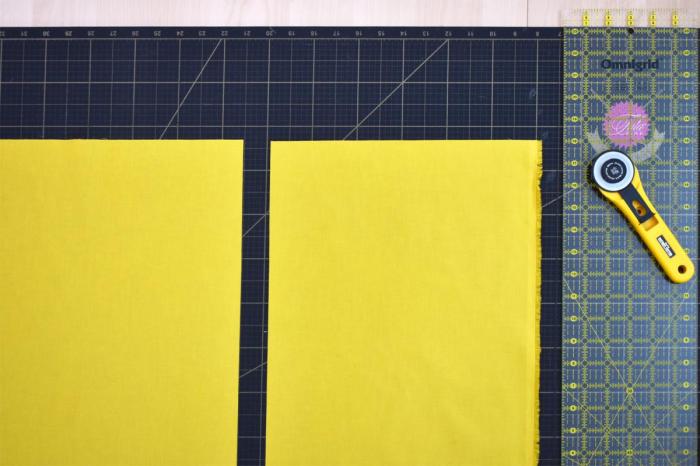
Now that your leather pieces are cut and prepared, it’s time to stitch them together to create your pillow cover. Sewing leather requires some special considerations, but with the right techniques, you can create strong and durable seams that will last for years.
Sewing Machine Techniques
Sewing leather on a sewing machine requires a heavy-duty needle and a strong thread. Here are some tips for using a sewing machine to sew leather:
- Use a leather needle: These needles are designed to pierce through the thick leather without breaking.
- Choose a strong thread: Leather needs a thread that won’t break easily. Use a thread made specifically for leather or a heavy-duty thread.
- Adjust the tension: Leather can be difficult to feed through a sewing machine. You may need to adjust the tension on your machine to prevent puckering or skipping stitches.
- Use a walking foot: A walking foot helps to evenly feed the leather through the machine, preventing the layers from slipping.
- Use a stitch length of 10-12 stitches per inch: This will create a strong and durable seam.
- Sew slowly: Leather can be tough on your sewing machine. Sew slowly and carefully to prevent any damage to the machine.
Hand-Stitching Techniques
Hand-stitching leather is a time-honored tradition that can create beautiful and durable seams. Here are some tips for hand-stitching leather:
- Use a leather needle: Leather needles are strong and sharp, making them ideal for hand-stitching leather.
- Choose a strong thread: Leather needs a thread that won’t break easily. Use a thread made specifically for leather or a heavy-duty thread.
- Use a thimble: A thimble protects your finger from the needle while you stitch.
- Use a stitch length of 10-12 stitches per inch: This will create a strong and durable seam.
- Use a stitch that is suitable for leather: There are several different stitches that are well-suited for leather. Some popular options include the saddle stitch, the back stitch, and the blanket stitch.
Stuffing the Pillow
The final step in creating your textured leather pillow is stuffing it with the right filling to achieve the desired comfort and firmness. The choice of stuffing material significantly impacts the pillow’s feel and longevity.
Stuffing Options
The type of stuffing you choose will influence the pillow’s firmness, resilience, and overall comfort. Here’s a look at some popular options:
- Polyester Fiberfill:This is a common and affordable stuffing choice. It’s soft, fluffy, and provides a comfortable feel. However, it can flatten over time and lose its shape.
- Down and Feather:Known for its luxurious feel and exceptional breathability, down and feather stuffing offers a plush and supportive experience. It’s also naturally hypoallergenic and resistant to dust mites. However, it can be expensive and requires regular fluffing to maintain its loft.
- Memory Foam:This material conforms to your body shape, providing pressure relief and support. It’s ideal for those seeking a firmer pillow with excellent durability. However, it can be less breathable than other options and may trap heat.
- Buckwheat Hulls:This natural stuffing option offers a unique feel, providing firm support and good breathability. Buckwheat hulls are also hypoallergenic and resistant to dust mites. However, they can be noisy when you move your head.
Determining the Right Amount of Stuffing
The amount of stuffing you use will determine the firmness and support of your pillow. For a softer pillow, use less stuffing. For a firmer pillow, use more stuffing. You can always adjust the amount of stuffing later by adding or removing it.
Tip:It’s always better to start with a little less stuffing and add more as needed. You can always add more stuffing, but it’s harder to remove it once it’s inside the pillow cover.
Stuffing the Pillow Cover
Once you’ve chosen your stuffing material, you can start filling the pillow cover.
- Gather your materials:You’ll need your pillow cover, stuffing material, and a measuring cup or spoon.
- Start filling the pillow cover:Begin by adding a small amount of stuffing to the cover, about a quarter of the way full.
- Distribute the stuffing evenly:Use your hands to gently distribute the stuffing throughout the pillow cover. Make sure it’s evenly distributed and there are no lumps or clumps.
- Add more stuffing as needed:Continue adding stuffing until you reach the desired firmness. You can always add more stuffing later if needed.
- Close the pillow cover:Once you’re satisfied with the firmness, close the pillow cover securely using the zipper, buttons, or ties you’ve chosen.
Finishing Touches and Care
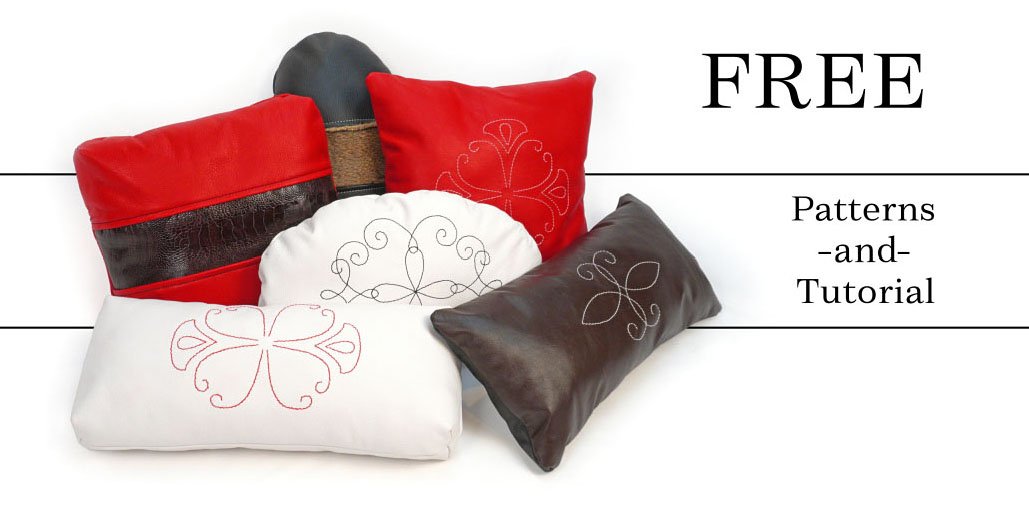
Now that your textured leather pillow is complete, it’s time to add some finishing touches and ensure its longevity. A few thoughtful details can elevate your creation from a simple pillow to a statement piece.
Adding Decorative Elements
Adding decorative elements to your leather pillow can enhance its visual appeal and reflect your personal style. Here are some suggestions:
- Stitching: Embroidered stitching, either in a contrasting color or matching the leather, can create intricate patterns or Artikels, adding a touch of elegance. A simple running stitch along the edges of the pillow can also provide a neat finish.
- Embellishments: Leather can be adorned with various embellishments, such as metal studs, rivets, or even beads. These elements can be arranged in a pattern or strategically placed for a unique look.
- Fringe: Leather fringe can be added to the edges of the pillow, creating a bohemian or rustic feel. It can be cut from the same leather or used in a contrasting color for a bolder statement.
Caring for Your Textured Leather Pillow
Leather is a natural material that requires proper care to maintain its beauty and durability. Here are some tips for caring for your textured leather pillow:
- Dust Regularly: Use a soft cloth to dust the pillow regularly, removing any accumulated dirt or debris.
- Avoid Direct Sunlight: Prolonged exposure to direct sunlight can cause the leather to fade and become brittle.
- Spot Clean: For minor stains, use a damp cloth with mild soap.
- Conditioning: Condition the leather periodically with a leather conditioner to keep it supple and hydrated. This will help prevent cracking and preserve the texture.
Inspirational Design Ideas
Once you’ve mastered the basics of crafting a textured leather pillow, it’s time to let your creativity soar! There’s a world of possibilities when it comes to designing unique and eye-catching pillows that perfectly complement your home decor.
Exploring Texture and Color Combinations
The beauty of textured leather lies in its versatility. You can create a wide range of visual effects by combining different textures and colors. Consider these ideas:
- Embossed Leather:Embossed leather features intricate patterns pressed into the surface, adding depth and dimension. Combine an embossed leather with a smooth leather in a contrasting color for a sophisticated look. For example, a deep brown embossed leather with a light beige smooth leather would create a timeless and elegant combination.
- Distressed Leather:Distressed leather has a vintage appeal with its faded and worn appearance. Pair it with a solid-colored leather in a complementary shade to create a rustic and charming aesthetic. For instance, a distressed brown leather paired with a rich burgundy leather would evoke a cozy and inviting ambiance.
- Suede Leather:Suede leather offers a soft and velvety texture that adds a touch of luxury. Combine suede with a smooth leather in a contrasting color for a bold and eye-catching effect. For example, a deep green suede leather with a bright yellow smooth leather would create a vibrant and energetic statement.
Incorporating Textured Leather Pillows into Different Interior Styles
Textured leather pillows can effortlessly enhance various interior design styles, adding warmth, texture, and visual interest.
- Modern Style:Modern interiors often embrace clean lines, minimalist aesthetics, and a focus on functionality. Textured leather pillows in neutral tones like gray, black, or white can add a touch of sophistication and texture to a modern living space. Consider using leather with subtle geometric patterns or embossed designs to complement the clean lines of modern furniture.
- Bohemian Style:Bohemian decor is characterized by eclecticism, layering, and a free-spirited vibe. Textured leather pillows in vibrant colors and bold patterns can add a touch of bohemian flair to a room. Consider using leather with ethnic motifs, fringe details, or distressed finishes to create a layered and eclectic look.
Experiment with color combinations like deep red and turquoise, or emerald green and mustard yellow.
- Rustic Style:Rustic interiors often embrace natural elements and a sense of warmth and comfort. Textured leather pillows in earthy tones like brown, beige, or olive green can complement a rustic aesthetic. Consider using leather with distressed finishes, embossed woodgrain patterns, or natural stitching to enhance the rustic feel.

